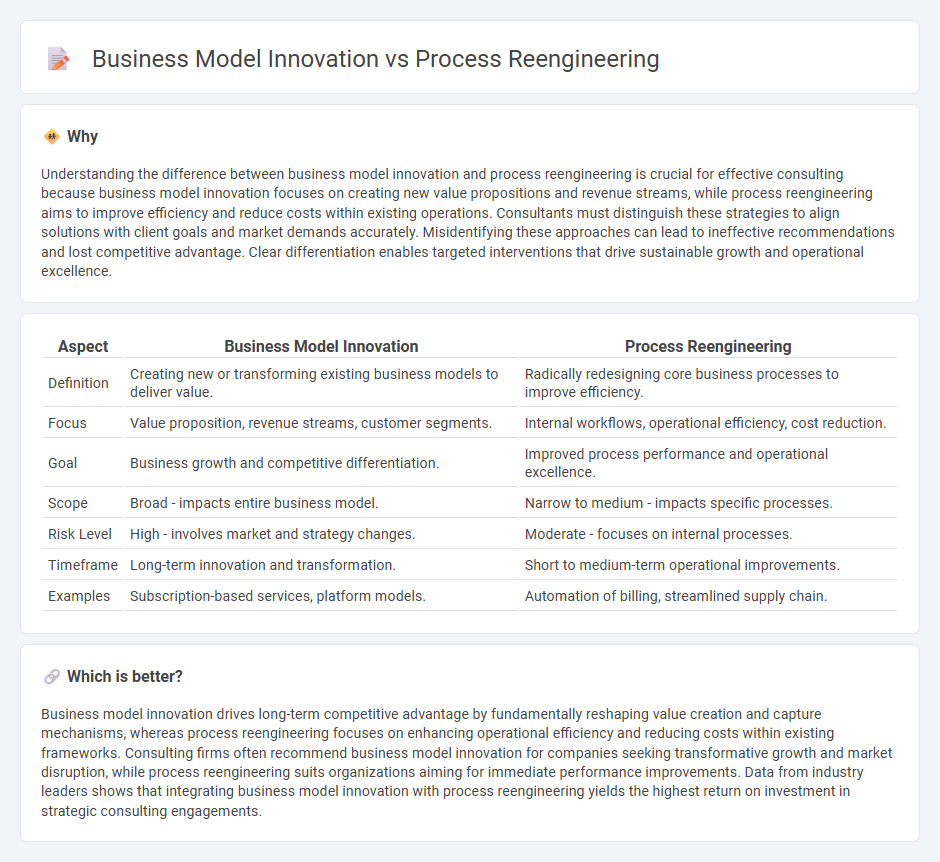
Business model innovation focuses on creating new value propositions and revenue streams by redefining how a company delivers products or services, transforming market positioning and customer engagement. Process reengineering targets the optimization of existing operational workflows to enhance efficiency, reduce costs, and improve service quality without changing the core business model. Explore how integrating both strategies can drive sustainable growth and competitive advantage.
Why it is important
Understanding the difference between business model innovation and process reengineering is crucial for effective consulting because business model innovation focuses on creating new value propositions and revenue streams, while process reengineering aims to improve efficiency and reduce costs within existing operations. Consultants must distinguish these strategies to align solutions with client goals and market demands accurately. Misidentifying these approaches can lead to ineffective recommendations and lost competitive advantage. Clear differentiation enables targeted interventions that drive sustainable growth and operational excellence.
Comparison Table
| Aspect | Business Model Innovation | Process Reengineering |
|---|---|---|
| Definition | Creating new or transforming existing business models to deliver value. | Radically redesigning core business processes to improve efficiency. |
| Focus | Value proposition, revenue streams, customer segments. | Internal workflows, operational efficiency, cost reduction. |
| Goal | Business growth and competitive differentiation. | Improved process performance and operational excellence. |
| Scope | Broad - impacts entire business model. | Narrow to medium - impacts specific processes. |
| Risk Level | High - involves market and strategy changes. | Moderate - focuses on internal processes. |
| Timeframe | Long-term innovation and transformation. | Short to medium-term operational improvements. |
| Examples | Subscription-based services, platform models. | Automation of billing, streamlined supply chain. |
Which is better?
Business model innovation drives long-term competitive advantage by fundamentally reshaping value creation and capture mechanisms, whereas process reengineering focuses on enhancing operational efficiency and reducing costs within existing frameworks. Consulting firms often recommend business model innovation for companies seeking transformative growth and market disruption, while process reengineering suits organizations aiming for immediate performance improvements. Data from industry leaders shows that integrating business model innovation with process reengineering yields the highest return on investment in strategic consulting engagements.
Connection
Business model innovation and process reengineering are interconnected through their shared goal of enhancing organizational efficiency and value creation. Business model innovation redefines how a company delivers value to customers and captures revenue, while process reengineering focuses on redesigning internal workflows to improve productivity and reduce costs. Together, they drive competitive advantage by aligning operational processes with innovative business strategies, enabling faster adaptation to market changes and increased customer satisfaction.
Key Terms
Workflow Optimization (Process Reengineering)
Process reengineering focuses on radically redesigning workflows and processes to achieve significant improvements in efficiency, quality, and cost reduction, often through automation and elimination of redundant tasks. Business model innovation, in contrast, transforms the core value proposition and revenue mechanisms of a company rather than its operational workflows. Explore how workflow optimization can drive operational excellence and competitive advantage in your organization.
Value Proposition (Business Model Innovation)
Business model innovation centers on redefining the value proposition to create unique offerings that meet evolving customer needs and unlock new revenue streams. Process reengineering, in contrast, focuses on optimizing internal workflows and operational efficiency without altering the core value delivered to customers. Discover how transforming your value proposition can drive sustainable growth and competitive advantage by exploring business model innovation in depth.
Organizational Change
Process reengineering centers on radically redesigning existing workflows to enhance efficiency and reduce operational costs within an organization. Business model innovation involves creating entirely new value propositions and revenue streams by altering how a company delivers products or services to customers. Explore deeper insights on how these strategies drive impactful organizational change and competitive advantage.
Source and External Links
Business Process Reengineering - Bain & Company - Business Process Reengineering (BPR) is the radical redesign of business processes to achieve dramatic improvements in productivity, cycle times, quality, and satisfaction by reassessing work to deliver customer value, simplifying and automating tasks, reorganizing teams, and rethinking outsourcing roles.
Business process re-engineering - Wikipedia - BPR is a comprehensive management strategy from the 1990s that involves analyzing and redesigning workflows and business processes to improve efficiency, effectiveness, and adaptability, starting with a high-level reassessment of mission and goals to fundamentally rethink and optimize core processes for improvements in cost, quality, service, and speed.
Business Process Reengineering: Benefits, Examples & Guide - BPR is a transformative strategy to completely revamp business operations, following key steps such as mapping current processes, analyzing for gaps, identifying improvement opportunities, designing the future state, and implementing changes for significant gains in productivity and quality.
 dowidth.com
dowidth.com